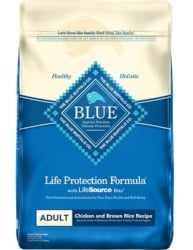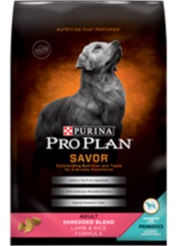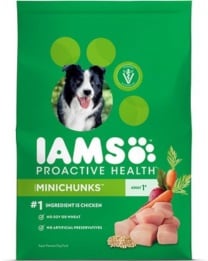
Owning a dog is hard work. You really need to pay attention to taking your dog on walks, giving them a lot of attention and cleaning after them. If you think that’s hard, wait till you shop for dog food.
You might be surprised once you see aisle upon aisle of different varieties of dog food. Don’t worry, keep reading because deciding on which brand of dog food will be way easier once you’re more informed.
Safety and Recalls
The first thing that comes to every dog owners’ minds when it comes to dog food is: “is this safe for my dog?” Safety is a highly understandable concern.
As a dog owner, you would want your dog to be only putting safe and nutritious foods into its system.
While it is indeed understandable to assume commercial dog foods are safe for your pet, you’d be surprised as to what is inside them.
Check the Package
Check each package of dog food before buying them. An informed and cautious dog owner would check every ingredient included in the dog food and not only the flavor.
Unfortunately, there have been studies linking certain ingredients in dog food to heart disease.
Dog food that includes ingredients based from peas, lentils, or potatoes were unfortunately linked to canine dilated cardiomyopathy (DCM). This is based on several studies.
Even the US Food and Drug Administration (FDA) sent out an alert to veterinarians and the public, warning dog owners about this food-disease connection.
DCM causes the heart to dilate and enlarge, causing problems for the heart such as difficulty in pumping and valve leakage.
If you own a small dog, then you might be able to breathe a little easier. This connection has been found to be more prominent in larger dog breeds - implying that the phenomenon has a genetic component involved.
At least in the case for DCM, you can check the dog food prior to purchase whether it is pea-, lentil-, or potato-based. Unfortunately, there are also ingredients in the dog food that may not be listed in the packaging.
Chemical Used in Euthanasia
The US FDA has sent out an advisory warning that several dog food brands were tested positive for a chemical commonly used in euthanasia.
Pentobarbital, the chemical found in several dog food samples, is a drug used in both animals and humans.
It is used in veterinary clinics and shelters for euthanasia. It is also used on prison inmates sentenced to death. So far, the labs have only tested for the presence of this chemical in dog food.
However, the FDA has reported that the levels may not be enough to pose any sort of health risk.
This did not satisfy Gravy Train though, one of the dog food companies whose samples tested positive for pentobarbital.
Their spokesperson stated: “the presence of this substance at any level is unacceptable to us and not up to our quality standards.”
Grain Free or Not
Concerned dog owners are constantly asking whether their dogs need diets without gluten or grain - a reasonable question. However, before delving into the answer, we have to discuss how grain-free is different from gluten-free.
Grain-free and gluten-free are not the same thing. Grain-free food are foods that are prepared without any grains such as wheat or barley.
While some dogs are completely fine with grain in their diet, there are a few reasons why dog owners prefer feeding their pets without grain.
Allergies
Firstly, the best reason people feed their dogs grain-free dog food is when their dogs are allergic to it. They can be allergic to one, some, or even all grains.
If you want to make sure your dog isn’t allergic to grain, then make sure to watch out for these symptoms:
- Inflamed skin
- Itchiness
- Excessive hair loss
- Flatulence
- Vomiting
Personal Beliefs
Another reason why some dog owners opt to feed their dogs grain-free diets is their personal belief that dogs did not evolve to eat grain.
As carnivores, it is understandable to think that the evolutionary ancestors of dogs did not eat grain.
However, after millions of years, don’t worry about it because dogs have evolved to be perfectly capable of digesting and metabolizing different carbohydrate sources - including grains.
Gluten-free food means that the food is free of any gluten, a protein commonly found in grains. However, gluten isn’t present in all grains, which means dog food can have grains but not gluten.
The main reason dogs should be fed gluten-free food is when they have been diagnosed with celiac disease, the disorder where gluten can cause an immune response in our intestines.
Wet or Dry
Dog food comes in all shapes and sizes and you’re going to have your hands full. However, one of the first things you have to decide is whether you want your dog to have wet or dry dog food.
The difference is more or less self-explanatory and each kind has its own pros and cons.
Affordable
More or less, you’re going to begin with dry dog food just like most people. Dry dog food is easy to deal with. Firstly, they’re way more affordable than their wet counterpart.
Dry dog food can come in these large bags and they’re easy to portion too.
Convenient
The convenience of measuring dry dog food makes it easy to monitor a dog’s diet. Dry dog food has also been known to clean dogs’ teeth in the process of chewing them as they act as an abrasive.
You can also use bits and pieces of dry dog food as treats. This is something that will really come in handy when you’re training them.
Why Wet Dog Food?
If dry dog food seems so great, why would people buy wet dog food?
There are several reasons why wet dog food is better than dry dog food. After a meal, dogs eating wet food feel fuller than if they ate dry dog food.
Wet food is also great for older dogs for several reasons.
Easier for Senior Dogs
One, wet dog food is easier for the old dogs to chew. Age weakens bones and older dogs just don’t have the same energy as they used to in their prime to chew dry food.
The second reason why wet dog food is great for older dogs is that as they age, their sense of smell has declined significantly. Wet dog foods are richer in both sense and taste, making them more palatable to old dogs.
Ultimately, wet dog food has the overall advantage of getting water into dogs’ bodies. Feeding a dog wet food is a great response to dogs who don’t drink enough water.
When is a Premium Brand Worth It?
For all intents and purposes, a premium brand can only be differentiated from other brands by one definitive measure: the price. Surely, a premium brand will be one that is more expensive than the majority of products in the market.
Most people assume that premium brands are more expensive because they are more nutritious than less expensive brands. That assumption may not necessarily be right all the time.
The only thing you can be sure of when buying a premium brand is that you’re going to be paying more for food you can get for less. If that is the case, when is a premium brand worth it? Premium brands are more than worth it for several occasions:
Your Dog Prefers It
Firstly, if you’ve tried all other products and you’ve found that your pet is more inclined to and showing healthier symptoms with a premium brand, then stick with it. If your dog won’t eat anything else, then a premium brand is worth it.
Recommended by Vets
Another occasion a premium brand is worth it is if a trusted veterinarian recommends it. The recommendation may not be the best for your dog, but until you give it a try, you’ll never know.
The only reason why people think premium brands are better is because there’s a connotation that higher prices accompany better quality. People think that dogs are at their best when fed with high-quality food.
Prepare the Food Yourself
Aside from premium brands, there are other ways you can ensure your dog receives high-quality food. The best way to make sure your dog is getting high-quality and nutritious food is to prepare the food yourself.
While generally regarded as the best way, it is completely understandable as to why this way may not be the most convenient for you.
Another way to prepare high-quality dog food is to start with commercial dog food, premium or not. Then, add supplements at the recommendation of your veterinarian. This makes even the most affordable dog food healthier and even more palatable to your dog.
How Dog Size Influences Food Type
Dogs come in all shapes and sizes, which means that there is no one best food for all dogs. Each dog is unique and so are their nutritional requirements. That being said, a good rule for thumb is choosing the type of food based on the size of your dog.
Which size do you think needs more calories: larger or smaller dog breeds? It’s actually the smaller dogs that would need more calories in their diets. This is because smaller dogs have faster metabolisms than larger dogs.
On the other hand, larger dogs may require special diets. Dogs that are more on the larger side tend to be prone to some diseases and a strict diet can help with prevention.
As dogs get older, they also become less and less active. You may not notice this right away so you keep feeding it the same amount you always did. This is a common practice that leads to dogs becoming overweight.
Easy ways to change a dog’s diet for weight loss is to reduce their food portion, lessen carbohydrates and increase protein.
Breed
Aside from size, there are other factors that can be taken into consideration when it comes to choosing food for your dog. The breed is also a good indicator as to what kind of food you should be feeding them.
Active breeds such as a Collie or a Husky require great amounts of calories in their diets to compensate for their energy output. Purebred dogs also tend to be prone to breed-specific diseases.
Look up whether you can help prevent these diseases with a special diet.
Pet Food Sensitivities
Just like people, there are several reasons (typically medical) as to why dogs may need a specialized diet. As previously mentioned, dogs can be allergic to certain foods.
But even more so, dogs can have an immune response and intolerances to certain food.
Allergens and intolerances can be caused by food, including beef, dairy, chicken, lamb, fish, wheat and soy. However, what is the difference between an intolerance and allergies.
Intolerances vs Allergies
Simply put, intolerances are when the body cannot metabolize a certain food while allergies are immune responses. You’ve probably heard of a person being lactose intolerant, which is a common intolerance in humans.
Dogs can also be lactose intolerant and you’d notice if your dog starts vomiting and exhibiting excessive flatulence after ingesting dairy.
Intolerances are not necessarily lethal, but if you know your dog is intolerant to certain food, then you have to cater to their diets accordingly.
On the other hand, dog allergies work exactly the same way as allergies do in humans. Allergies are immune responses to certain materials - the body reacting defensively to typically harmless things.
This is why peanuts may be safe for you but deadly to the next person.
The easiest way to spot whether your dog is allergic to a certain food is to see if your dog is excessively scratching itself after a meal. Food allergies in dogs often manifest as skin rashes and itches.
A specialized diet can also be prepared for the purpose of weight loss.
Marketing Hype
One thing you cannot avoid is the fact that dog foods are sold by companies. These companies are trying to compete with one another, usually with their marketing.
While there are many factors that go into marketing - such as advertising, packaging and labelling - studies show that nutrition is still the primary factor that influences buyers.
Walk along the dog food aisle and be bombarded by their trendy words such as premium, healthy and all-natural. These are all common marketing words, but are these the words you should look out for? Well, they aren’t necessarily words to avoid.
However, those words should not be the basis for your decision. Look for words that refer to their ingredients and quality. For example, the label “Certified Humane” implies that the food product is made of animals that were treated humanely.
Organic/Holistic/Homemade
Companies throw around a lot of fancy words to catch your eye and influence your decision. However, there are some words that are thrown more commonly than others.
These words are plastered on almost every bag and can. However, what do they really mean?
Organic
Starting with organic food, tons of packages have them. But ask yourself:
What IS organic and what does it take for food to be called organic?
Basically, dog foods have to be mostly made of organic ingredients to have the label. The ingredients can only be called organic if they have been handled and treated as defined by the USDA.
This includes meat from livestock raised without growth drugs and hormones as well as crops farmed without fertilizers and pesticides.
Holistic
This is a trickier word to define. Even the government has no definition for “holistic,” which is why dog food companies can just put them anywhere they want.
Basically, what these companies are trying to imply with their products being “holistic” is that their food aims to nourish your dog as a whole. This is as opposed to other dog foods that only aim to satisfy the dogs’ nutritional requirements.
Holistic nourishment, or so they claim, treats the dog as a whole and tries to satisfy its mental and emotional requirements aside from just their physical requirements.
To feed a dog holistically, these dog foods often come with additional ingredients and supplements to provide that extra kick.
Top 5 Brands

Wag is a US brand that fills their products with all the nutrition your dog will need for growing up healthy and strong. Based off a family-owned facility, the company offers a wide selection of dog foods your pet will surely enjoy.
Aside from being well-reviewed and highly-regarded by hundreds of satisfied customers, Wag does produce nutritious products for dogs with vitamins - from vegetables and good healthy fatty acids from salmon oil.
They also make dog food without any grain, so there is no need to worry about allergies. Do note that many customers have commented that their dry dog food is easily crushed in the bag, ending up with a lot of wasted dog food into powder.

Blue Buffalo is another company that markets nutritious dog food. Coming in different flavors and sizes, Blue Buffalo emphasizes how important meat is to dogs. They make sure to use high-quality meat in all their products for strong muscle development.
Healthy and tasty, Blue Buffalo dog food comes with quality meat and vegetables for all the amino acids and vitamins a dog will need.
The dog food also comes with veterinarian-recommended supplements such as minerals, antioxidants and other nutrients to help your pet stay fit and strong.
While most reviews for the company has been stellar, there have been a number of complaints regarding their food being easily contaminated and causing illnesses.

Another great company with great products, Purina Pro Plan offers a wide selection of meat-based flavors such as chicken, salmon, lamb and beef. They use rice as the main carbohydrate source in all their products.
The company also offers a selection based on nutritional requirements. This means that you can have dog food that specifically targets physical supplementation like for sport dogs or even mental development for puppies.
The company relies on a team of over 400 scientists and almost a century of research to make sure their formulas are what’s best for dogs.
The company has enjoyed high praise over the years, but have recently started getting flak. This is because regular customers noticed changes such as less quality in food and increased prices. There have also been some reports where their products caused some dogs to fall ill.

Hill’s Science Diet, as the name implies, relies on their clinically-proven products. They have a very wide range of products for all dogs, shapes, sizes and occasions.
With their formulas developed over decades of research with hundreds of veterinarians, the brand trusts science for their success.
Aside from different products of different flavors, Hill’s Science Diet also offers products for different conditions such as their Sensitive Stomach & Skin Dry Food, Sensitive Stomach & Skin for Small & Toy Breed Dry Food, Grain Free Dry Food and many more.
While generally regarded as a great brand, their products have had reports of not being effective and even causing illness to some dogs.

Iams is another great dog food company that provides healthy and nutritious dog food. Recommended by veterinarians far and wide, Iams provides products with real meat and filled with nutrients like vitamins and antioxidants.
The company also includes healthy fatty acids that promote health in dogs’ coats and skin. However, many dog owners are averted by the company’s use of ingredients such as corn meal, chicken by-products and ground sorghum.
Bottom Line - Can You Really Protect Your Pet?
The final and most important question. And it won’t help that the answer is tricky: yes and no. Yes, you can really protect your pet. The fact that you’re all the way here means that you want to be an informed consumer and good dog owner, which is a great step to take.
Being informed, you know what to look for in dog food and what makes them all different from one another. But also, you won’t be able to protect your pet, especially from unforeseen circumstances.
You will have to experiment which dog food is best for your dog and it is inevitable that there is a chance you might feed your dog something it won’t agree with. However, at least your knowledge will lessen the chances of that ever happening.
In the end, you’re going to trust that your dog knows best. After all, only your dog will know if it will like the dog food or not.
Further Reading...
Check out some of our most popular dog product reviews; everything from online retailers to more dog food products.
- Chewy.com Reviews - Read about one of the most popular online dog supply retailers.
- The Farmer's Dog Reviews - Popular all natural dog food brand.
- Allivet.com Reviews - Online pharmacy for all your pet needs.
- Rover.com Reviews - The go to site to find pet sitters and dog walkers.
- TruDog Reviews - An all meat based food option for your dog.
- Dr. Marty Nature's Blend Reviews - Popular online brand currently heavily advertising their dog food.
- Ultimate Pet Nutrition Reviews - Another popular brand advertising online to spread the message of their natural pet foods.